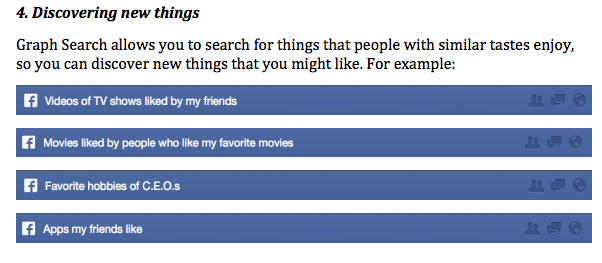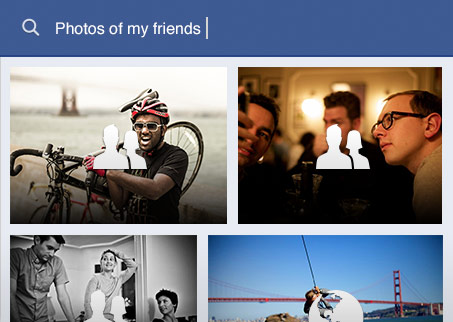Photos and the news feed are where people spend their time on Facebook. Yet its last two big products were relatively niche features, Timeline and the new Graph Search. Facebook today published examples of how to use Graph Search, which merely highlight that it’s not part of day-to-day life. Yes, Facebook needed to fix search, but it may have prioritized an engineering wank over the user experience.
As Facebook told me last week, Graph Search now has hundreds of thousands of users, up from the approximately 100,000 who first got the rollout (those without it can sign up for earlier access). But it seems Facebook thinks people aren’t using it enough or exploring its full potential. So to encourage usage, it wrote a blog post of “some favorite searches,” despite the fact that less than one in one thousand people have access to Graph Search.
The suggested queries include searching for videos or old photos of friends, who you know that’s engaged, and photos from popular news sources. There are also location and interest-discovery examples like hotels near a landmark, ski resorts friends have been to, places you’ve visited, apps and videos your friends Like, hobbies of people with prestigious professions, and what people with similar interests to you Like.

But look at that list. Are any of those things you’d search for regularly, if ever? Maybe you’d take the occasional sweep through nostalgic content, look at recommendations for a vacation, or go hunting for new distractions. However, there’s little chance you’ll spend nearly as much time Graph Searching as browsing the daily refresh of status updates and photos from your close friends.
That’s a little worrisome, especially since it follows a trend. In September 2011, Facebook’s big launch was Timeline. Beautiful, sure. But how often do you dive years back into your profile, or those of friends? Facebook poured tons of resources into the ability to call up historic content. For what? When I visit most people’s profiles, I look at their recent photos, last few posts, and About section. All of these were handled just fine by the old version of the profile. Adding cover images may have been sufficient.
Timeline and Graph Search are necessary building blocks for telling your life’s story by uploading content and letting the world browse that information. There’s monetization potential through sponsored Graph Search results. And if it can get better data on what people Like and where they go, Graph Search could be crucial to Facebook’s long-term value. I repeat, Graph Search is very important as it quietly ties Facebook’s content together.

Still, these features are only critical on a rare occasion. For Facebook to call Graph Search “The Third Pillar” in a flashy launch event may have been a mistake. Instead, it could have more subtly brought back Advanced Search with a new design, allowing you to identify friends in a specific city, or find people you met by just first name and a handful of characteristics. These are what people actually need Facebook search for. Graph Search is being noisily pitched as a fun feature to play with it when it’s really about data, not engagement.
Meanwhile, the news feed has in many ways looked the same since it launched in…get this…2006. And photos haven’t gotten a major redesign since 2010. A new way to browse an aggregated stream of photos (with some sponsored advertisement photos inserted) could add hours to everyone’s monthly usage and create a new money-maker. A more visual alternative to the text-filled news feed column could make the social network more informative and addictive, too. Luckily Facebook is working on a radically visual redesign of the mobile feed, as I detailed last month.
Facebook has long prided itself on the user experience. Well, photos and the feed are what we experience. So the fact that they’re languishing as it over-engineers the edges of the site makes me wonder if Facebook has drifted a bit too far from what its 1 billion users care about.































Comment